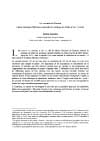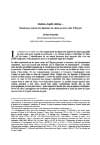Jerome Gonzalez
« à propos dâune confusion tardive dans lâemploi de wnn (Être) et wn (ouvrir) »
ENiM 1, 2008, p. 1-6.
 Cet article est lâoccasion de souligner quâune combinaison de vignettes du Livre des Morts peut ÃĐclairer le contenu modifiÃĐ dâune formule ÂŦ canonique Âŧ. Ainsi, la substitution de wnn, ÂŦ Être, exister Âŧ par wn, ÂŦ ouvrir Âŧ, dans la formule 103 du LdM, relÃĻve de la proximitÃĐ thÃĐmatique des formules 91/92 et 103, reliÃĐes de façon iconique dans le P. Louvre E 17400.
Cet article est lâoccasion de souligner quâune combinaison de vignettes du Livre des Morts peut ÃĐclairer le contenu modifiÃĐ dâune formule ÂŦ canonique Âŧ. Ainsi, la substitution de wnn, ÂŦ Être, exister Âŧ par wn, ÂŦ ouvrir Âŧ, dans la formule 103 du LdM, relÃĻve de la proximitÃĐ thÃĐmatique des formules 91/92 et 103, reliÃĐes de façon iconique dans le P. Louvre E 17400.
 This contribution is the reason for stressing that a combination of Book of the Dead vignettes can throw a light on the modified contents of a âcanonicalâ spell. Thus, the substitution of wnn, âbe, existâ by wn, âopenâ, in BD spell 103, belongs to the vicinity of the topics of spells 91/92 and 103, joined together in an iconic way in P. Louvre E 17400.
This contribution is the reason for stressing that a combination of Book of the Dead vignettes can throw a light on the modified contents of a âcanonicalâ spell. Thus, the substitution of wnn, âbe, existâ by wn, âopenâ, in BD spell 103, belongs to the vicinity of the topics of spells 91/92 and 103, joined together in an iconic way in P. Louvre E 17400.
 Consulter cet article (42737) -
Consulter cet article (42737) -  Télécharger cet article au format pdf (26186)
Télécharger cet article au format pdf (26186)
« Le cercueil de Peniou. MusÃĐe national dâHistoire naturelle de Santiago du Chili (no inv. 11.160) »
ENiM 2, 2009, p. 109-128.
 Lâanalyse du cercueil de Pȝ-n(y)-jw (XXXe dyn. â dÃĐbut de lâÃĐpoque ptolÃĐmaÃŊque ; MusÃĐe dâhistoire naturelle de Santiago du Chili â MNHN 11.160) permet de mettre en lumiÃĻre lâemploi dâune boiserie en trompe-lâÅil originale et son rapport avec diffÃĐrents motifs religieux, notamment deux figures dâAnubis anthropomorphe adoptant la posture ksw.
Lâanalyse du cercueil de Pȝ-n(y)-jw (XXXe dyn. â dÃĐbut de lâÃĐpoque ptolÃĐmaÃŊque ; MusÃĐe dâhistoire naturelle de Santiago du Chili â MNHN 11.160) permet de mettre en lumiÃĻre lâemploi dâune boiserie en trompe-lâÅil originale et son rapport avec diffÃĐrents motifs religieux, notamment deux figures dâAnubis anthropomorphe adoptant la posture ksw.
 The analysis of the Pȝ-n(y)-jwâs coffin (Dynasty 30 â Ptolemaic Period; Museo Nacional de Historia Natural, Santiago of Chile â MNHN 11.160) allows to throw a light on the use of an original woodwork in trompe lâoeil and his relationship with various religious motives, specially two anthropomorphic Anubis in the ksw posture.
The analysis of the Pȝ-n(y)-jwâs coffin (Dynasty 30 â Ptolemaic Period; Museo Nacional de Historia Natural, Santiago of Chile â MNHN 11.160) allows to throw a light on the use of an original woodwork in trompe lâoeil and his relationship with various religious motives, specially two anthropomorphic Anubis in the ksw posture.
 Consulter cet article (49152) -
Consulter cet article (49152) -  Télécharger cet article au format pdf (23984)
Télécharger cet article au format pdf (23984)
« Maltais, trophÃĻ, ktÃĻsios... Remarques autour des figurines de chien en terre cuite dâÃgypte »
ENiM 4, 2011, p. 159-196.
 Le prÃĐsent article se propose dâidentifier la valeur emblÃĐmatique des terres cuites de chiens maltais fabriquÃĐs en Ãgypte. Une origine iconographique propre au monde grÃĐco-romain a ÃĐtÃĐ confirmÃĐe (dÃĻs le VIe-Ve siÃĻcle av. J.-C.). Ensuite, il sâest agit de se demander comment ces objets de consommation courante ont pu Être ÂŦ lisibles Âŧ dans lâÃgypte grecque et romaine. La docilitÃĐ et la trophÃĻ infantile initialement ÃĐvoquÃĐes par le chien maltais sont rÃĐinvesties dans le jeu des rapports sociaux prÃĐsidÃĐs par la notion de ÂŦ parentalisation Âŧ. à cela sâajoute la valeur dâapprovisionnement alimentaire au cÅur des mÃĐcanismes communautaires. Le rÃĐinvestissement est tel, que sous lâEmpire, le chien maltais plus souvent individualisÃĐ quâassociÃĐ Ã lâenfant-dieu Karpocrate / Harpocrate, passe de qualificatif (statut de la prime enfance) à entitÃĐ pleinement autonome. En ce sens, la terre cuite de chien maltais pourra intÃĐgrer les foyers (ktÃĐsios), les greniers à blÃĐ (anatropheus), les fortins (trophÃĻ militaire)âĶ
Le prÃĐsent article se propose dâidentifier la valeur emblÃĐmatique des terres cuites de chiens maltais fabriquÃĐs en Ãgypte. Une origine iconographique propre au monde grÃĐco-romain a ÃĐtÃĐ confirmÃĐe (dÃĻs le VIe-Ve siÃĻcle av. J.-C.). Ensuite, il sâest agit de se demander comment ces objets de consommation courante ont pu Être ÂŦ lisibles Âŧ dans lâÃgypte grecque et romaine. La docilitÃĐ et la trophÃĻ infantile initialement ÃĐvoquÃĐes par le chien maltais sont rÃĐinvesties dans le jeu des rapports sociaux prÃĐsidÃĐs par la notion de ÂŦ parentalisation Âŧ. à cela sâajoute la valeur dâapprovisionnement alimentaire au cÅur des mÃĐcanismes communautaires. Le rÃĐinvestissement est tel, que sous lâEmpire, le chien maltais plus souvent individualisÃĐ quâassociÃĐ Ã lâenfant-dieu Karpocrate / Harpocrate, passe de qualificatif (statut de la prime enfance) à entitÃĐ pleinement autonome. En ce sens, la terre cuite de chien maltais pourra intÃĐgrer les foyers (ktÃĐsios), les greniers à blÃĐ (anatropheus), les fortins (trophÃĻ militaire)âĶ
 The purpose of this article is identifying the symbolic value of the Maltese dogs terracottas made in Egypt. An iconographic origin was confirmed for the Greco-Roman world (from VIth-Vth cent. B.C.). Then, it is of wondering how these objects of regular consumption were able to be âreadableâ in Greek and Roman Egypt. The docility and the infantile trophe initially evoked by the Maltese dog are reinvested in the social relationships, chaired by the notion of âparentalisationâ. In it is added the value of food supply, a main part of the community mechanisms. Under the Empire, the Maltese dog, more often individualized than associated with the child-god Karpocrates / Harpocrates, became a complete autonomous entity rather the qualifier it was initially (status of the infancy). This way, the terracotta of Maltese dog can join homes (ktesios), granaries (anatropheus), forts (military trophe)âĶ
The purpose of this article is identifying the symbolic value of the Maltese dogs terracottas made in Egypt. An iconographic origin was confirmed for the Greco-Roman world (from VIth-Vth cent. B.C.). Then, it is of wondering how these objects of regular consumption were able to be âreadableâ in Greek and Roman Egypt. The docility and the infantile trophe initially evoked by the Maltese dog are reinvested in the social relationships, chaired by the notion of âparentalisationâ. In it is added the value of food supply, a main part of the community mechanisms. Under the Empire, the Maltese dog, more often individualized than associated with the child-god Karpocrates / Harpocrates, became a complete autonomous entity rather the qualifier it was initially (status of the infancy). This way, the terracotta of Maltese dog can join homes (ktesios), granaries (anatropheus), forts (military trophe)âĶ
 Consulter cet article (40663) -
Consulter cet article (40663) -  Télécharger cet article au format pdf (22671)
Télécharger cet article au format pdf (22671)
« Ã propos dâun titre spÃĐcifique dâaprÃĻs la documentation saÃŊte dâOxyrhynchos »
ENiM 8, 2015, p. 1-9.
 Identification du titre jmy-nww transmis par la documentation ÃĐcrite issue des fouilles dâel-Bahnasa / Oxyrhynchos.
Identification du titre jmy-nww transmis par la documentation ÃĐcrite issue des fouilles dâel-Bahnasa / Oxyrhynchos.
 Identification of the title jmy-nww transmitted by the written sources from excavations in el-Bahnasa / Oxyrhynchus.
Identification of the title jmy-nww transmitted by the written sources from excavations in el-Bahnasa / Oxyrhynchus.
 Consulter cet article (38968) -
Consulter cet article (38968) -  Télécharger cet article au format pdf (21492)
Télécharger cet article au format pdf (21492)
ENiM 15 - 2022
18 article(s) - 29 octobre 2024.
ENiM 1 à 17 (2008-2024) : 219 articles
3 752 929 téléchargements
7 034 976 consulations.
Index des auteurs

Mots clés

Derniers articles : 
CENiM - Mise en ligne des volumes ÃĐpuisÃĐs : 
 Anne-Sophie von BOMHARD DÃĐcans ÃĐgyptiens, CENiM 23, Montpellier, 2020 — (2020)
Anne-Sophie von BOMHARD DÃĐcans ÃĐgyptiens, CENiM 23, Montpellier, 2020 — (2020) 
 Jean-Claude Grenier L'Osiris ANTINOOS, CENiM 1, Montpellier, 2008 — (26 dÃĐcembre 2008)
Jean-Claude Grenier L'Osiris ANTINOOS, CENiM 1, Montpellier, 2008 — (26 dÃĐcembre 2008) 
TDENiM - Mise en ligne des volumes ÃĐpuisÃĐs : 
 Twitter
Twitter 3476338 visites - 2745 visite(s) aujourd’hui - 182 connecté(s)
© ENiM - Une revue d’égyptologie sur internet
Équipe Égypte Nilotique et Méditerranéenne - UMR 5140 - « Archéologie des Sociétés Méditerranéennes » (Cnrs) - Université Paul Valéry - Montpellier III




 , ÅĄnnw.w / ÅĄnn.w, ÂŦ manoeuvres dormantes Âŧ
, ÅĄnnw.w / ÅĄnn.w, ÂŦ manoeuvres dormantes Âŧ



















 Contact
Contact
 Abonnez-vous !
Abonnez-vous ! Équipe Égypte Nilotique et Méditerranéenne
Équipe Égypte Nilotique et Méditerranéenne UMR 5140 « Archéologie des Sociétés Méditerranéennes » (Cnrs)
UMR 5140 « Archéologie des Sociétés Méditerranéennes » (Cnrs) Université Paul Valéry - Montpellier III
Université Paul Valéry - Montpellier III